This post may contain affiliate links at no additional cost to you. As an Amazon Associate I earn from qualifying purchases. Click to view our full disclosure.
What's inside
Are you using a leg press for glutes? If not, now may be the time to start.
The hype of strong glutes is constant on social media, with endless exercises and booty flexes that could give anyone FOMO.
But should you use a piece of equipment like the seated leg press for glutes? I get questions like these every day as a personal trainer.
So to clear the air, I’m going to take you through five must-try leg press exercises to confidently target and tone your glutes.
We’ll cover the anatomy, benefits, and share a leg press glute workout to build mass and improve function.
Let’s jump in.
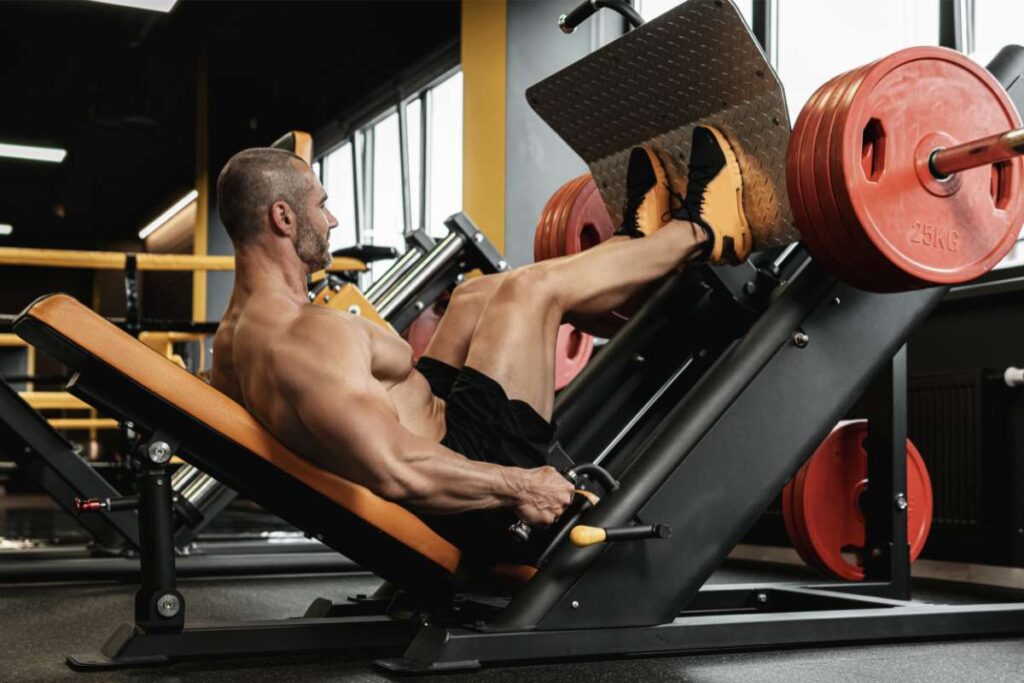
Anatomy of the Glutes
To begin, let’s cover the anatomy of the glutes. This will help you understand how they work, their function, and the best exercises to target each fiber.
| Muscle | Function | Exercise |
| Gluteus Maximus | Extends the hip | High Wide Leg Press, Vertical Leg Press to Lift |
| Gluteus Medius | Externally rotates, abducts and stabilizes the hip | Glute Band Leg Press, Single Leg Side Lying Leg Press |
| Gluteus Minimus | Abductor and externally rotates the hip | Glute Band Leg Press |
What is the leg press?
Related: 15 Best Leg Workouts With Dumbbells
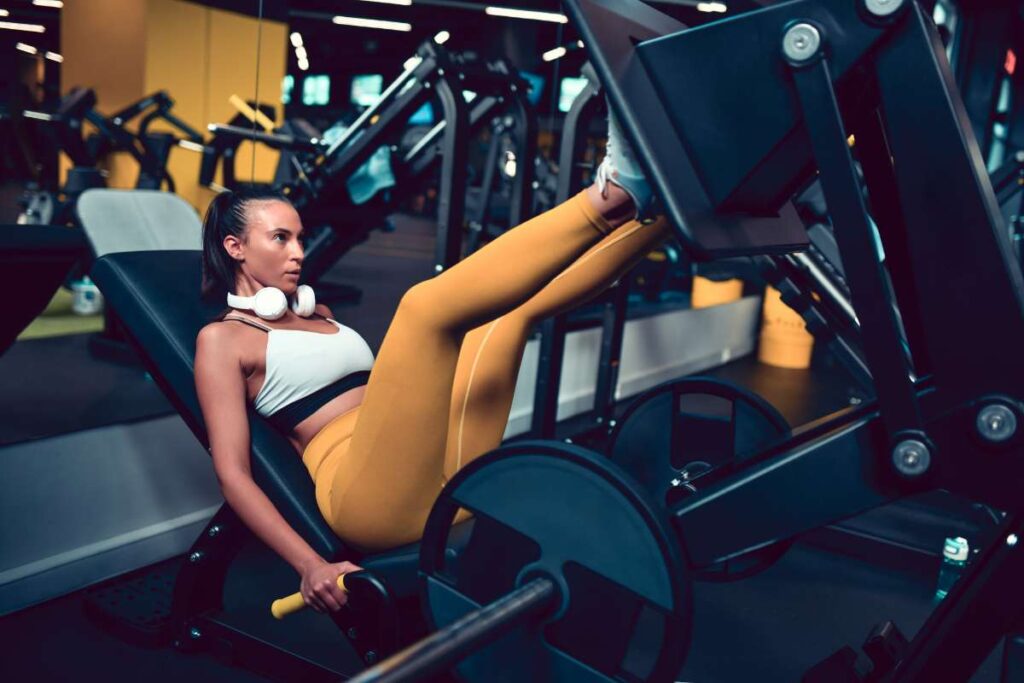
The leg press is a piece of gym equipment designed to target and strengthen the muscles of the lower body.
Coming in a variety of forms, the seated and 45° leg press are the most common. The movement is designed to push using your quadriceps and glutes to build lean muscle.
Is the leg press good for glutes?
Related: How To Get Big Legs?
If you do it right, yes. Your foot placement on leg press for glutes is everything. Your feet should be placed high on the platform.
Research suggests that when we alter our foot position, our muscle activity is different through the range of motion, putting a great bias on the glutes.
Based on these principles, the changes to foot and body position will likely help us target different muscles and build strong and functional glutes.
Main Benefits of Using the Leg Press for Glutes
Related: Tired Of Skinny Legs With Big Belly?
There is no doubt the leg press is a great piece of equipment for building the lower body, but let’s look at it strictly for its glute-building capabilities.
Increased Muscle Mass
The leg press is great for building the lower body, and that includes the glutes.
For a great glute contraction, position your feet high on the platform and focus on performing sets of eight to 12 repetitions at 60%-80% of your one repetition maximum.
This will help you target the glutes and stimulate muscle growth.
Improved Strength
To train for strength, perform sets of one to five repetitions at 80%-100% of your 1RM, with high foot positioning to take the fibers of the glutes through a full range of motion.
Other movements such as the barbell hip thrust and squat in the gym may be more suitable for building glute strength. Still, use the leg press for adding variety and volume to your training.
Reduced Risk of Injury
There is one thing leg presses have always had over free weights, and that is safety.
While the idea of positioning yourself under a carriage with a huge weight looks dangerous, leg presses are actually designed with safety as a top priority.
The seated leg press is a good example, as the weight is off to the side away from the body, while you can set your exact range of motion.
The 45° leg press has a safety lock, while the vertical leg press offers a range of motion limiter to stop the weight from dropping too far.
These mechanisms allow you to push your glute training to the limit with confidence.
Versatility
While the range of motion of a leg press may seem simple or one-dimensional, it can help us perform a wider variety of movements.
This helps us to target both sides or a single side, with the shift of our positioning letting us hit different fibers and target our glutes from every angle.
Convenience
If nothing else, targeting your glutes using the leg press is incredibly convenient. You simply load up the weight, hop on, and smash out a highly effective leg press glute workout.
This can be invaluable when you just aren’t feeling it after a long day at work or after a leg session.
The added benefit here is that you can load up one machine and hit the glute from a number of angles.
Drawbacks of Weak Glutes
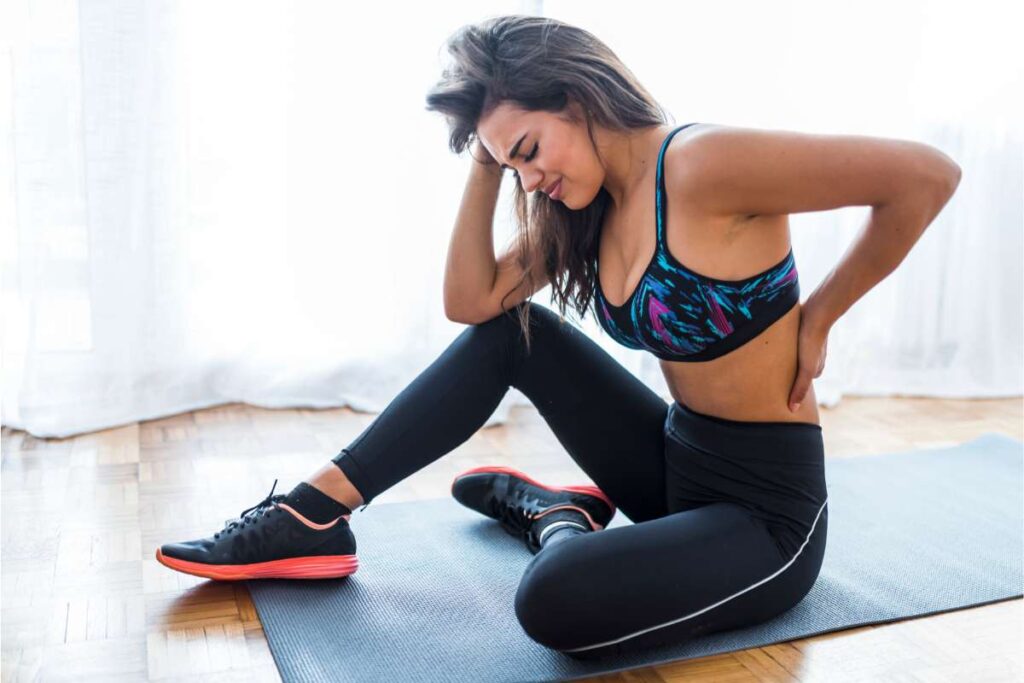
Having a great set of glutes is not only aesthetic; they are important for many of our lifts in the gym as well as our daily function.
Here’s a list of drawbacks for having weak glutes to help you further understand the purpose of correct glute training.
Lower Back Pain
The glutes and the lower back are anatomical neighbors. Therefore, it shouldn’t come as a surprise that having weak glutes can lead to lower back pain.
Studies have identified that there is a direct relationship between the glute weakness and non-specific lower back pain.
This is likely due to the responsibility of the glute in hip extension, which helps us when we’re walking, standing up, and lifting objects.
When the glutes are weak, we lose control of a powerful muscle, making the lower back pick up the slack. The result? Lower back pain.
To remedy this, research suggests strengthening the glutes as well as lower back exercise. Together, they can be effective in decreasing lower back pain.
Poor Function
The glutes support the biggest and strongest joint in our bodies, the hip. Hips are responsible for walking, sitting down, standing up, and lifting.
Weak glutes reduce the quality of these movements, making it difficult to perform even the most simple tasks.
Reduced Athletic Performance
Weakness in the glutes may also result in poor athletic performance due to inability of the glutes to fire and generate.
Studies have indicated that glute activation prior to exercise can be beneficial improving recruitment and movement quality.
Conversely, weak glutes below a base level of fitness may result in impaired performance.
Increased Risk of Injury
Having weak glutes may also increase the risk of injury both in a daily setting and during activities such as running.
As previously mentioned, weakness in the glutes will likely result in the poor function and force surrounding tissue such as the lower back to take the load.
Research suggests that gluteus medius weakness is linked to knee pain during running because strong glutes are needed to help stabilize the hips and correctly align the knee.
A lack of function and stability even at a base level of movement can lead to poor alignment to the hips, knees, and ankles.
This leads to pain through many different areas and results in injury down the line.
What are the different types of leg press machines?

A staple in most gyms, the leg press can be a great asset when developing and targeting your lower body.
Below are the different types of leg press machines to target and tone your glutes.
Seated Leg Press
The seated leg press, also known as a horizontal leg press, is a base, introductory-level machine perfect for new lifters. Its comfortable seating sees the lifter sit on the carriage and control their weight.
One of the best benefits of this is that you can set the depth of your squat prior to your set, ensuring that you don’t go past your limit when lowering.
The other added benefit is that this machine uses a weight stack, which is safely situated off to the side.
So, if you fail during your set and the weights come down, you’ll be well out of harm’s way.
45-Degree Leg Press
The 45° leg press is a crowd favorite among many lifters as it positions you directly below the carriage loaded with weight at a 45° angle.
The carriage has a huge weight capacity and is typically on rails, providing smooth movement as you press.
This makes it excellent for loading up the weight and training for increased mass.
The system is also complete with a safety lock mechanism located near the handles, making for an easy lockout in the occurrence of failure.
You’ll appreciate the added peace of mind, especially when you are smashing through your heaviest sets.
Vertical Leg Press
The vertical leg press is an awesome piece of equipment that is sadly not seen in many mainstream gyms.
This apparatus has you lie on your back directly below the carriage. It requires you to place your feet on the carriage platform with your hips flexed at 90° angle.
The result? Incredible hip flexion and glute contractions.
Based on this description alone, it is clear to see why this contraption is either only used by advanced lifters or rarely seen in gyms at all.
However, in lieu of the vertical leg press, many who want the same benefits set up a Smith machine in a similar fashion. It can provide deep hip flexion and glute-targeting goodness.
How To Use a Leg Press for Glutes

Effectively using the leg press for glutes comes down to foot positioning to maximize depth and length of the glute fibers.
This can be done by placing your feet shoulder width apart, high on the platform, which will allow you to go lower into the leg press.
The caveat here is that you need to maintain contact between your lower back and the padding to ensure there is no unwanted pressure on the lower back.
This position will also make it far more difficult to generate force to push the carriage back up. That’s why I recommend reducing the weight for the initial sets.
Once you can successfully go to your desired depth with a quality contraction, all while keeping your back flush with the pad, then you can consider upping the weight.
5 Best Leg Press Exercises for Glutes
Now that we have addressed why you need to have stronger glutes and why the leg press is the machine for the job, it’s time to take you through the five best leg press exercises for your glutes.
1. High Wide Leg Press
The high wide leg press is a great way to add extra depth to your press and take your hips through greater flexion.
Equipment Requirements
- 45° Leg Press
- Weight Plates
How To Perform the High Wide Leg Press
- Sit down on the leg press and place your feet on the platform.
- Position your feet high on the platform with a wide stance.
- Push up with your legs to take the weight of the carriage.
- Unlock the safety bars.
- Begin by lowering the carriage down toward your body.
- Lower until your knees are bent at 90 degrees.
- Push back up to the starting position and repeat.
Benefits
- Targets glutes
- Builds lower body mass
Pro Tips
- If you are new to this foot placement, start with a lighter weight and familiarize yourself with range of motion.
- When you are lowering the carriage, stop before your lower back is about to round. This will help you avoid injury.
2. Side Lying Single-Leg Press
The side lying single-leg press is excellent for building unilateral strength and taking the glute through its full range of motion.
Equipment Requirements
- 45° Leg Press
- Weight Plates
How To Perform the Side Lying Single-Leg Press
- Sit down on the leg press and lean toward your side at a 45° angle.
- With your leg closest to the carriage, place your foot on the platform.
- Position your foot on the platform at a 45° angle.
- Start by pushing the carriage up to take the weight.
- Unlock the safety bars.
- Lower the carriage down until your knee is bent at 90 degrees.
- Then, push back up to the starting position. Switch sides and repeat.
Benefits
- Takes glute fibers through a greater range of motion
- Builds unilateral leg and glute strength
Pro Tips
- To begin, perform this movement with just the carriage. This is a weaker movement as it is single-leg and side lying. It does not need a lot of weight to be effective.
- Contrate on breathing, inhaling as your lower and exhaling as you push up.
3. Vertical Leg Press to Lift
The vertical leg press to lift is an incredible exercise for targeting the glutes. The addition of the lift gives your glutes that extra pump as it takes the hips through a great degree of extension.
Equipment Requirements
- Vertical leg press
- Weight plates
How To Perform the Vertical Leg Press to Lift
- Lie down on the bench and place your feet on the platform.
- Position your feet shoulder-width apart.
- Push your feet up and unlock the safety bars.
- Start by lowering the platform down toward your body.
- Lower until your knees are bent at 90 degrees.
- Then, push back up until your legs are straight.
- Once your legs are straight, push your hips up off the platform for great hip extension.
- Return your hips down to the bench. Repeat.
Benefits
- Greater hip extension increases glute contraction.
- Builds lower body mass
Pro Tips
- Start with a lighter weight with this one. The vertical leg press is a complex machine and the carriage weight can provide a challenge.
- Focus on keeping your lower back on the bench as you lower and really extend at the top of the movement. Focus on squeezing the glutes for greater activation.
4. Glute Band Leg Press
The glute band leg press is excellent for targeting the gluteus medius and adding further glute bias to the leg press movement.
Equipment Requirements
- 45° Leg Press
- Weight Plates
- Booty Band
How To Perform the Glute Band Leg Press
- Sit down on the leg press and loop the band around your legs just above your knees.
- Lift your feet up onto the platform and position them high and wide.
- Push up, take the weight of the carriage, and unlock the safety mechanism.
- Lower the carriage down toward your body until your knees are bent at 90 degrees.
- Push the platform back to the starting position and repeat.
Benefits
- Band forces knees to externally rotate, targeting the gluteus medius
- Targets all glute fibers
Pro Tips
- Begin with a lighter weight and focus on working against the band and squeezing your glutes. Once you are comfortable with the movement and the bands, increase the weight.
- Focus on breathing, inhaling as you lower and exhaling as you push up.
5. High Single-Leg Press
The high single-leg press takes the benefits of a high and wide leg press and allows us to target one leg at a time. This is great for building unilateral strength.
Equipment Requirements
- 45° Leg Press
- Weight Plates
How To Perform the High Single-Leg Press
- Take a seat on the leg press and place one foot high on the platform.
- Push up with your leg and unhook the safety.
- Lower the carriage down toward your body until your knee is bent at 90°.
- Push back up to the starting position. Repeat.
Benefits
- Builds unilateral strength
- Great for isolation of legs and glutes
Pro Tips
- Start with a lighter weight as the carriage can be challenging with a single leg.
- Slowly lower and focus on squeezing the glutes and quadriceps as you push the platform back up.
Best Leg Press Workout Program for Glutes

To take full advantage of the exercises listed above, here are two programs to help you build and tone your glutes.
There’s an advanced and beginner program, each complete with exercises, sets, reps, rest, and weekly schedule to help you plan ahead for building strong, toned glutes.
Each program can be performed as an individual program or as a part of a leg or push day.
Beginner Weekly Schedule
| Mon | Tues | Wed | Thur | Fri | Sat | Sun |
| Rest | Train | Rest | Rest | Train | Rest | Rest |
Beginner Leg Press Glute Workout (Duration 20 – 25 Minutes)
| Exercise | Sets | Reps | Rest |
| High Wide Leg Press | 4 | 8-12 | 45-60 secs |
| Glute Band Leg Press | 3 | 10-12 | 30-45 secs |
| Side Lying Single-Leg Press | 3 | 8-12 | 30-45 secs |
Advanced Weekly Schedule
| Mon | Tues | Wed | Thur | Fri | Sat | Sun |
| Train | Rest | Rest | Train | Rest | Rest | Rest |
Advanced Leg Press Glute Workout (Duration 35 – 40 Minutes)
| Exercise | Sets | Reps | Rest |
| Glute Band Leg Press | 4 | 10-12 | 45-60 secs |
| Vertical Leg Press to Lift | 4 | 10-12 | 30-45 secs |
| Side Lying Single-Leg Press | 4 | 12 | 30-45 secs |
| High Single-Leg Press | 3 | 8-10 | 30-60 secs |
| High Wide Leg Press | 4 | 10-12 | 30-45 secs |
Tips for Training Your Glutes on Leg Press
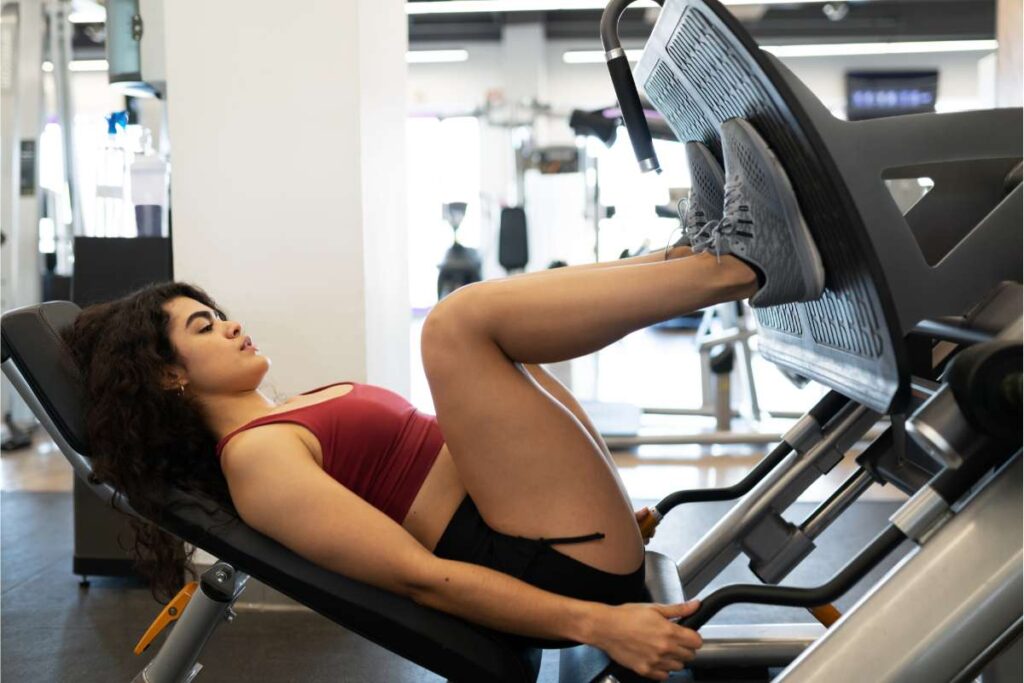
Targeting the glutes with leg press takes more than just jumping in and hoping for the best.
That is why I have some professional tips to help maximize your booty gains when using the leg press.
Calorie Surplus
First, let’s address the main thing that will have a considerable impact on your glute training – nutrition.
Whether you are training to pack on muscle or shredding for summer, correct nutrition is the key to getting real results.
If you are serious about making glutes grow, a calorie surplus is required to pack lean mass.
A calorie surplus with an additional 500-700 cal per day will help give your body the additional fuel to power through your glute workouts, while having enough protein to build lean muscle.
To hone in on your nutrition and maximize results, use our advanced calorie and macronutrient calculator.
Share your age, gender, height, weight, and activity level, and receive a precise calorie and macro intake
This will ensure you are getting enough protein to build lean muscle, carbs for energy and fat to absorb vital nutrients.
Prioritize Protein
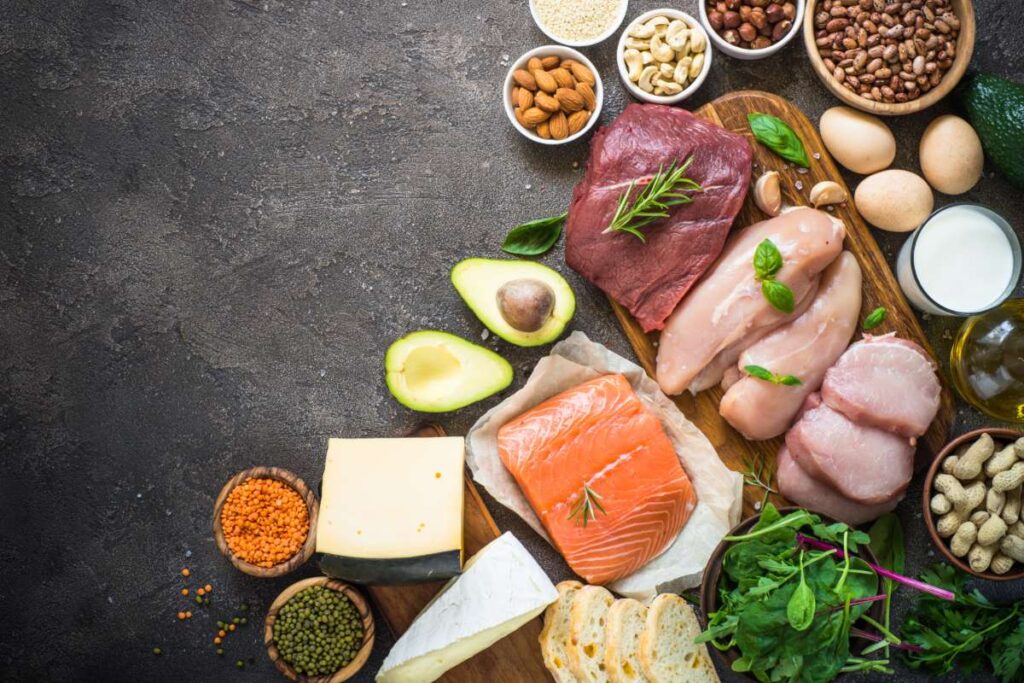
When we set out on the pursuit of building bigger, stronger glutes, it is essential that we are eating enough protein.
Protein not only helps us build lean muscle; it aids in our recovery and keeps us fuller for longer.
Studies recommend that 1.6g-2.2g of protein per kilogram of body weight is best to build lean muscle.
This can be done by eating protein rich foods such as lean meat, seeds, and nuts, or with the assistance of supplements such as shakes and bars.
Keep Lower Back On Padding
When you are targeting the glutes with the leg press, it is essential that you keep your back and your hips firmly against the seat and padding.
It can be tempting to lower as low as possible to increase stretch through the glute.
However, when this happens our pelvis posteriorly tilts and puts a tremendous amount of pressure on our lower back. This can result in sore lower back and even injury.
The key here, when you place your feet high and wide, is to gradually lower the weight until just before your pelvis begins to tilt.
While this may feel like you are stopping your lift short, it will still target your glute, minus the nasty post workout lower back sting.
Push Through the Legs
This may sound obvious, but when we are lifting we can get so caught up in moving the weight that we forget about our target muscle.
To increase contraction of the glutes, think about pushing with your thighs and extending the knees.
This removes your attention from the carriage and weight and helps you zone in on extension of the hip and knee to help you achieve an awesome glute contraction.
Increase the Weight Gradually
When we are using the leg press for glutes, we need to begin with a lighter weight with a plan to gradually increase.
While it can be tempting to stack on the weight and smash out a heavy set, this may make it difficult to activate the glutes.
By starting with a lighter load, you will be able to concentrate on establishing a solid mind-muscle connection with your glutes.
This will ensure that you are hitting them with every rep and maximizing your gains.
Final Thoughts
The leg press is a phenomenal tool for targeting and toning the glutes, improving your performance in and out of the gym.
The ability to simply sit down and safely get to work on building a stronger lower body makes it an essential for your lower-body training.
Just be sure to fuel your body with a high-protein, nutrient-dense diet, start with a lighter weight, focus on quality contractions, and the result will come.
So, are you thinking of expanding your glute training and using the leg press for glutes?
Which exercises interest you most or which have you already found success with?
Let us know in the comments.
Does the leg press work your glutes?
Yes, the leg press does work out glutes as the movement requires hip flexion to lower the platform.
When this happens, the glutes must lengthen as you lower and contract to extend the hip and push the platform up to the starting position.
How to do leg press for glutes?
To use a leg press for glutes, position your feet high and wide on the platform. To further increase glute activation, wrap a booty band around the knees to engage the gluteus medius and increase overall glute contraction.
What form of leg press is best for glutes?
The 45° leg press and the vertical leg press are the two forms of leg press that many lifters prefer for glute activation.
However, the leg press that is best for glute activation is the one you feel most comfortable on and the one you find to elicit the best contraction of your glutes.
How do you build glutes with a leg press machine?
To build the glutes using the leg press, place your feet high and wide on the platform and focus on pushing through the thighs, extending the knees and hips. This will ensure you get a quality glute contraction with each rep.
Are leg presses or squats better for glutes?
The squat is better for targeting the glutes as the hips go through greater range of motion and are taken to full extension. The leg press requires sitting during the movement and limiting range of motion.
Where to put feet on leg press for glutes?
When performing leg press for glutes, place your feet high and wide on the platform. This will allow for greater depth, increasing hip flexion and taking the glute through a greater contraction.

